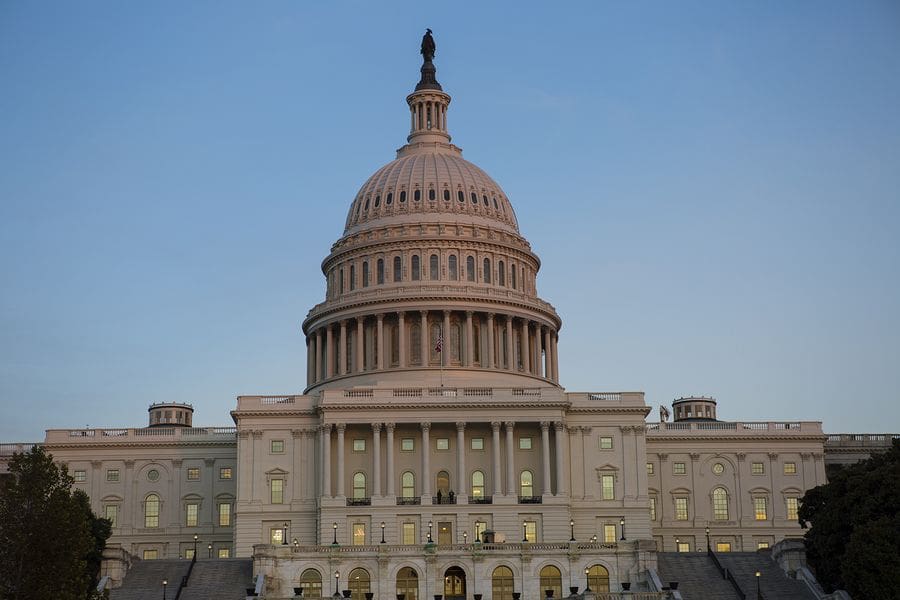You could be eligible for the federal employee student loan repayment program if you’re highly qualified and interested in working at a government agency. In this guide, we’ll cover everything you need to know about this federal employee student loan forgiveness option.
What is the federal student loan repayment program?

The federal student loan repayment program is designed to attract top talent to serve in the public sector and encourage retention as an additional employee benefit. Federal agencies can designate funds and offer student loan repayment assistance to highly qualified candidates.
Employees who are eligible for the federal student loan repayment program can receive up to $10,000 per year, up to a max amount of $60,000. Only federal student loans are eligible for federal employee student loan repayment. Private private student loan borrowers don't qualify.
Good news for Parent PLUS borrowers, though, who can also take advantage of this program if they’re an employee at the federal agency and took out federal loans on behalf of their child.
The important thing to note is that whether the funds are available and who the funds are available for are dependent on the federal government agency. So it’s not something everyone working full-time in the public sector can get. If the federal repayment program isn't available to you, check out the Public Service Loan Forgiveness (PSLF) program instead.
Your work has to have a program in place, and you’d have to qualify with eligible loans and pass the eligibility requirements below.
Though this type of student loan forgiveness for government employees can be a huge perk because the total award could be $60,000, one potential snag could be a higher tax bill. Unfortunately, the student loan repayment assistance is not tax-exempt and is included as part of your gross income on your tax return.
Who is eligible for this type of federal employee student loan forgiveness?
Federal employees are eligible for this program if they are considered “highly qualified.” The federal agency that you work for decides on an individual basis to provide student loan repayment assistance. The federal agency will make the student loan payments directly to the student loan holder.
There are more than 20 independent agencies that participate in this type of federal employee student loan forgiveness, as well as 15 cabinet-level departments. The federal agency may be looking for employees with specific degrees or for talent that serve in hard-to-fill positions.
Qualified candidates must sign a service agreement and commit to working for three years at the agency that’s offering student loan debt help. In order to continue the student loan repayment assistance, employees must meet job performance standards set by their employer.
In other words, you could lose this benefit if your performance is suffering at work. If you quit or get let go from the agency, you have to hand over those benefits and pay them back!
Related: PSLF Eligibility for Government Contractors: What You Need to Know
How to apply
If you have a hefty student loan balance and are interested in working in the public sector, the federal student loan repayment program can seem like a godsend. It’s a great benefit for public service workers, but it’s not as accessible as other types of student loan assistance.
Unlike income-driven repayment or PSLF, there’s no application process for federal employee student loan repayment.
What you can do instead is to look into the various federal agencies. You can check their websites to see if any information is posted about the federal student loan repayment program. You can also contact the agency directly to see what they’re looking for in a prospective employee regarding this benefit.
If you’re already working for a federal agency, talk to your supervisor for details on the program. As noted above, this program can vary by agency and may be offered case-by-case for a hard-to-fill position.
Alternatives to the federal student loan repayment program
If you do not currently qualify for this program but would like some type of student loan forgiveness for government employees, consider the PSLF program. There's also the time-sensitive IDR Adjustment and also the PSLF help tool to use in the process.
Under this program, you must work in the public sector at an approved agency with a qualifying employer for 10 years. For example, you may work at a government organization, family service agency, in public health, public interest law services, law enforcement, or at nonprofit organizations.
After making 120 qualified payments and meeting your service commitment, you can get the remainder of your student loans forgiven. You can complete the Employer Certification Form each year to stay on track with your employment.
Unlike the federal student loan repayment program, you won't pay taxes on the forgiven amount under PSLF. If you've submitted a PSLF application and didn't get approved, you can check out Temporary Expanded Public Service Loan Forgiveness (TEPSLF).
You can also consider income-driven repayment (IDR) forgiveness programs. The qualifying repayment plans include:
- Income-Based Repayment (IBR)
- Income-Contingent Repayment (ICR)
- Saving on a Valuable Education (SAVE), formerly called REPAYE
- Pay As You Earn (PAYE)
These plans are designed for high-balance borrowers who may have trouble making their payments affordable. Through IDR, your monthly payment is a small percentage (10% to 20%) of your discretionary income, so it's more affordable than the 10-year standard repayment plan.
After making payments for 20 to 25 years, you’re eligible for loan forgiveness if you have a remaining balance. Talk to your student loan servicer or set up a consult with a Student Loan Planner to discuss your options.
Evaluate your options

If you’re unsure what the best option is for your student loan repayment plan, consider these student loan forgiveness options for government employees and federal employees student loan forgiveness options side by side.
Look at the pros and cons and evaluate them against your personal and financial goals. To make repayment more manageable, you can also look into a Direct Consolidation Loan and student loan refinancing. You can also book a consultation with us to get an individualized plan that is unique to your situation.
Are you a federal employee? What do you think of these student loan repayment options? Comment below.
Refinance student loans, get a bonus in 2025
| Lender Name | Lender | Offer | Learn more |
|---|---|---|---|

|
$500 Bonus
For refinancing 100k or more (bonus from Student Loan Planner®, not SoFi®)
|
Fixed 4.49 - 9.99% APR
Variable 5.99 - 9.99% APR with all discounts with all discounts |
|

|
$1,000 Bonus
For 100k or more. $200 for 50k to $99,999
|
Fixed 4.45 - 9.89% APR
Variable 5.88 - 9.99% APR
|
|

|
$1,000 Bonus
For 100k or more. $300 for 50k to $99,999
|
Fixed 4.29 - 10.24% APPR
Variable 4.86 - 10.24% APR
|
|

|
$1,050 Bonus
For 100k+, $300 for 50k to 99k.
|
Fixed 4.99 - 8.90% APR
Variable 5.29 - 9.20% APR
|
|

|
$1,099 Bonus
For 150k+, $300 to $500 for 50k to 149k.
|
Fixed 4.88 - 8.44% APR
Variable 4.86 - 8.24% APR
|
|

|
$1,250 Bonus
For 100k+, $350 for 50k to 100k. $100 for 5k to 50k
|
Fixed 3.85 - 11.38% APR
Variable 4.33 - 12.35% APR with autopay with autopay |
Not sure what to do with your student loans?
Take our 11-question quiz to get a personalized recommendation for 2025 on whether you should pursue PSLF, SAVE or another IDR plan, or refinancing (including the one lender we think could give you the best rate).

Comments are closed.